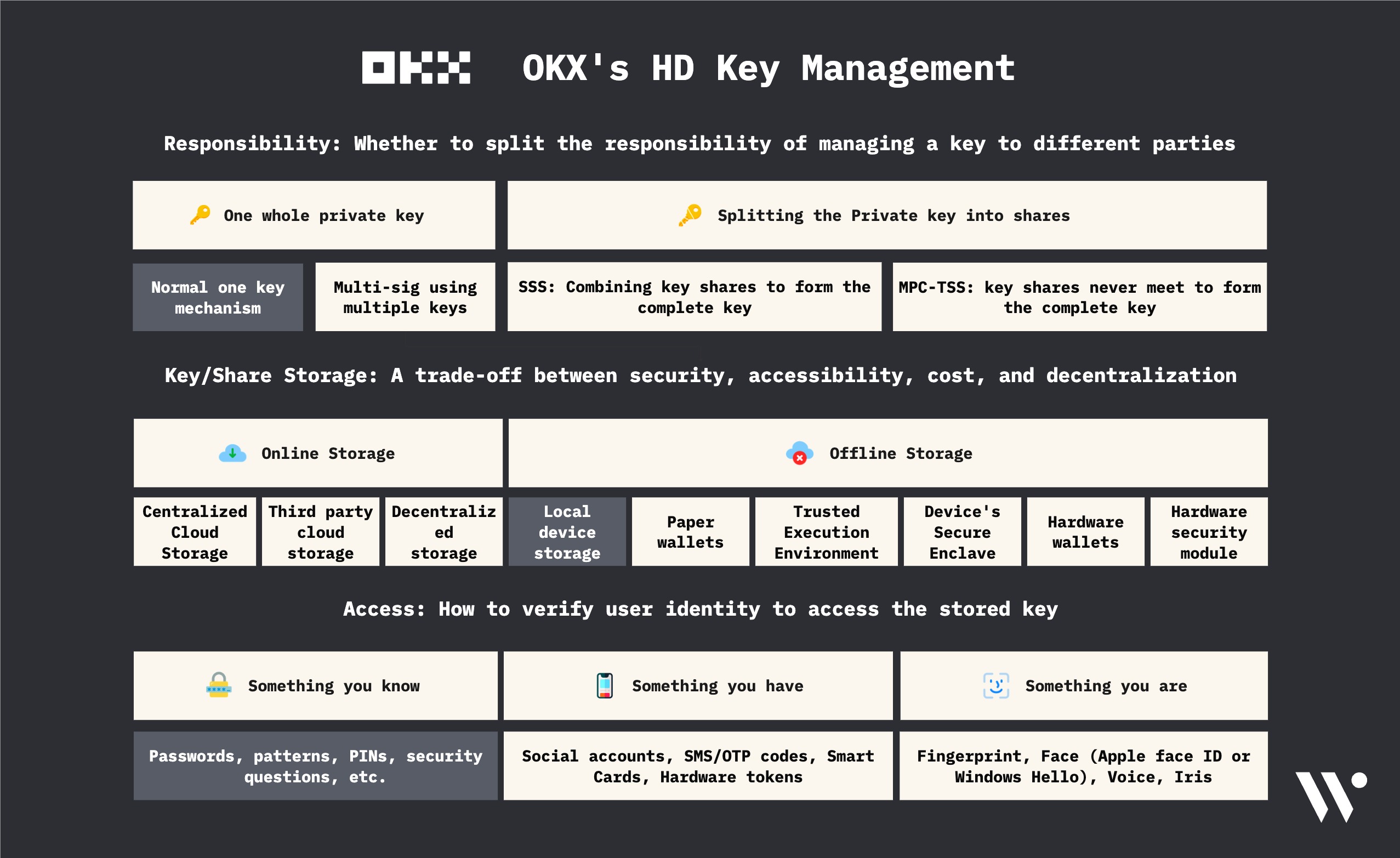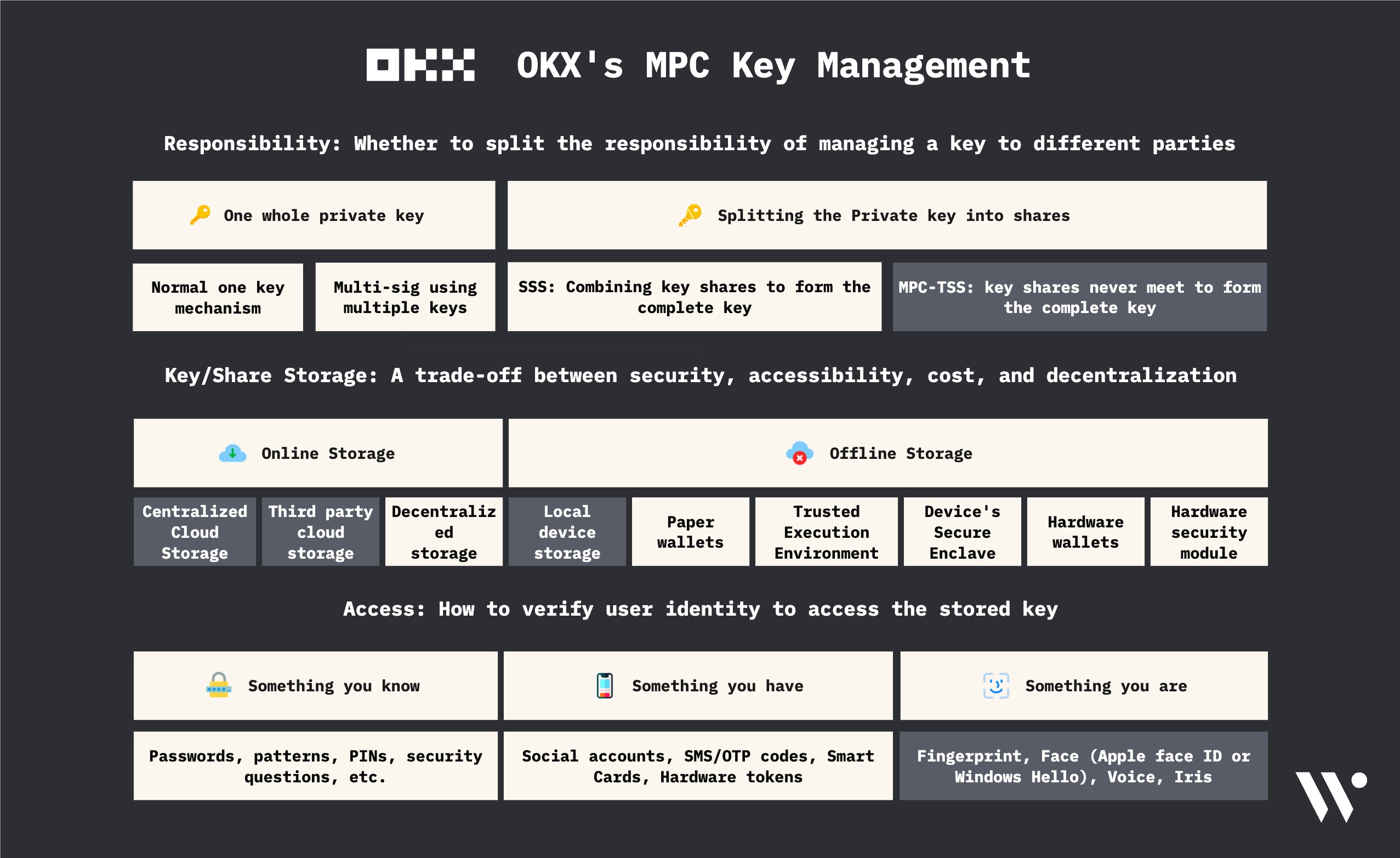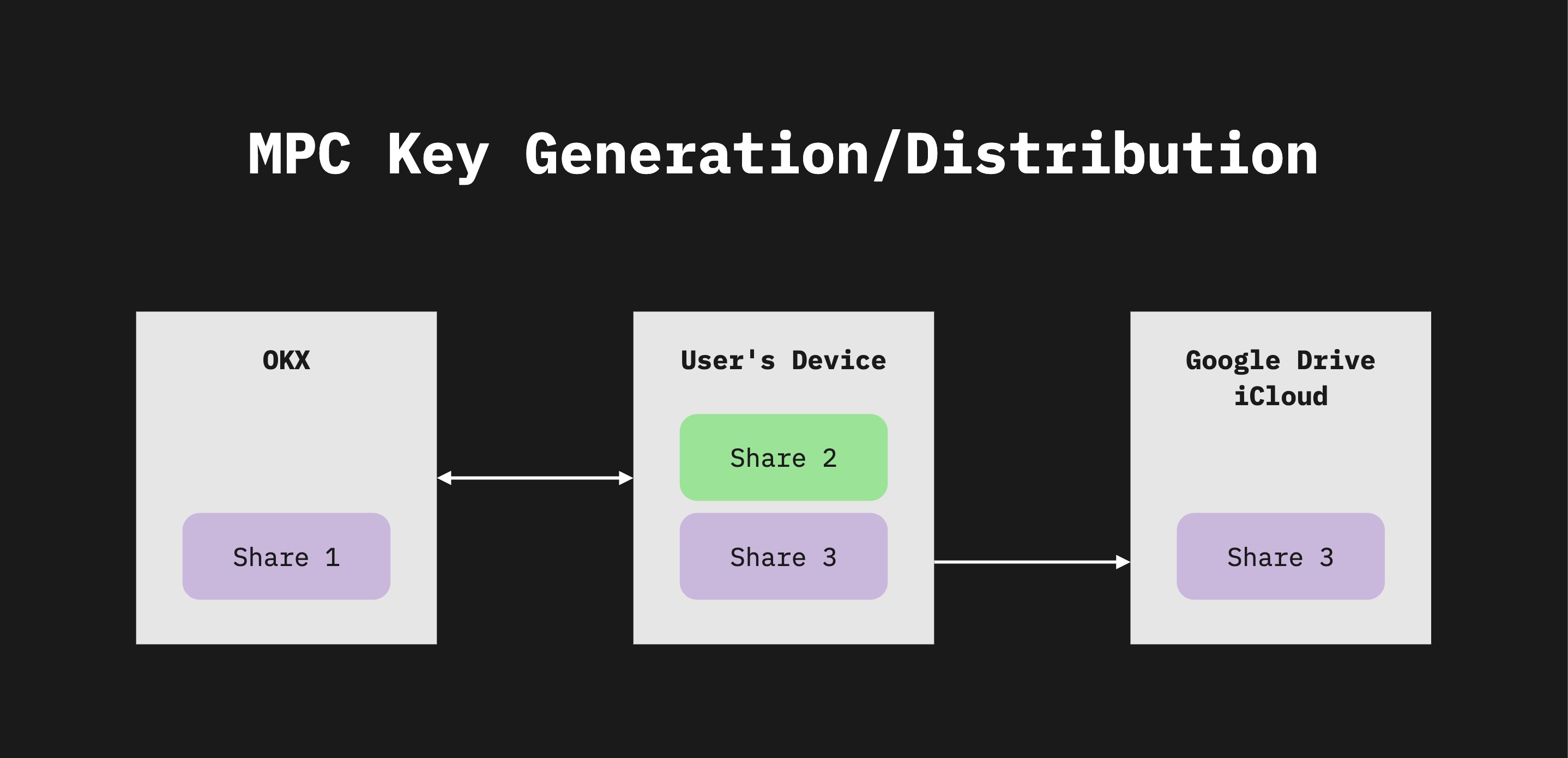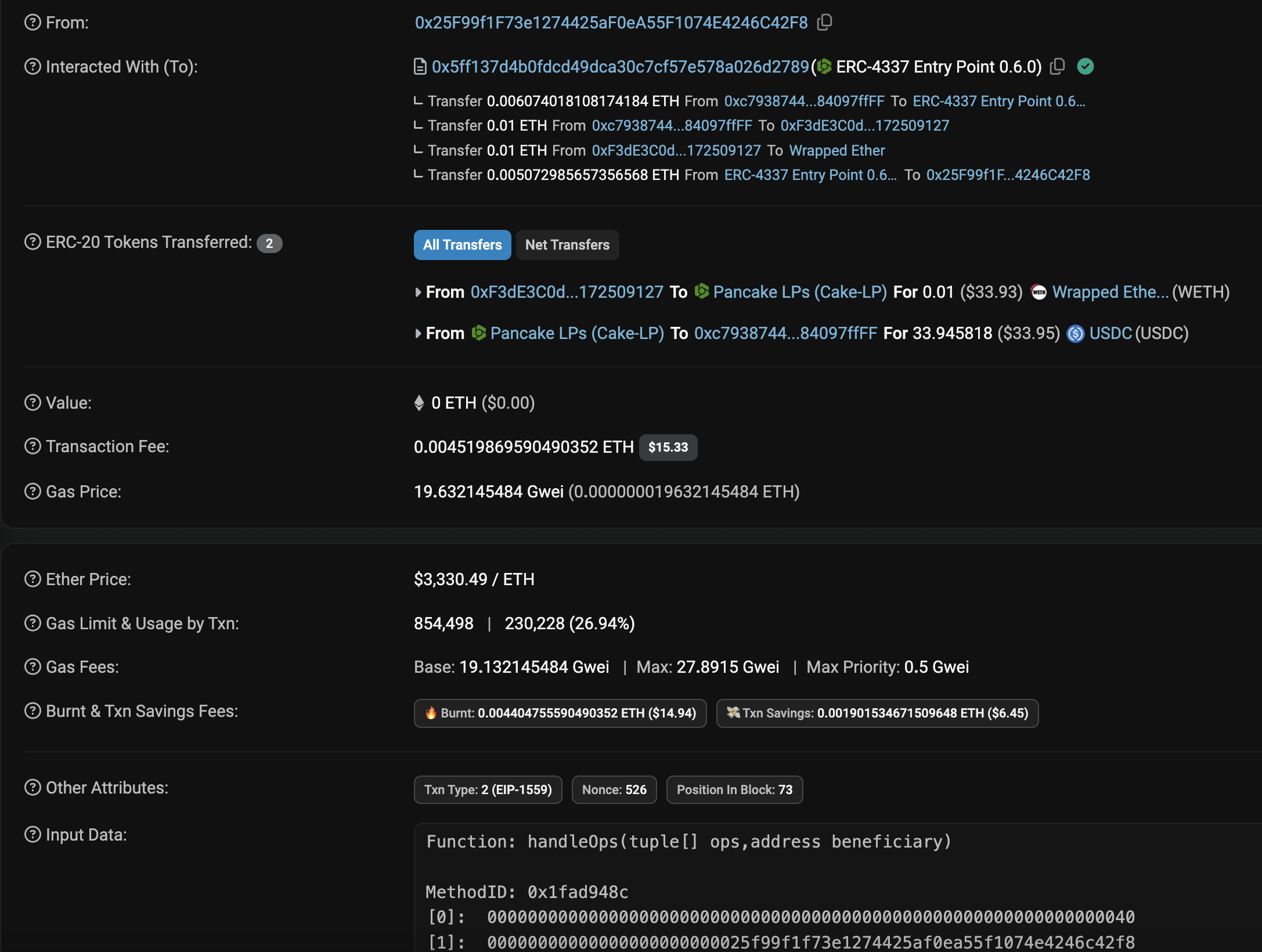
OKX Wallet
www.okx.com/web3Stats
Staking
Swap
Bridge
Daily Transaction Count (Smart Account)
Daily Deployed OKX Smart Accounts
Daily Active OKX Smart Accounts
Weekly Active OKX Smart Accounts
Activity
Security Analysis
Key Management
OKX wallet support 2 different key management options:
Standard HD Wallet

Responsibility
A single user is responsible for managing the private key (secp256k1key pair in this case). We’ll discuss the key generation process in detail in the next section.
Storage
where is the key stored in: - browsers - mobile devices (iOS, Android) The passkey is generated by the device’s Secure Enclave (in case of iOS devices) or similar modules (in case of Android devices). The passkey is locally stored on the device’s Secure Enclave (in case of iOS devices) or similar modules (in case of Android devices).
Access
The user can access Secure Enclave (in case of iOS devices) or similar modules (in case of Android devices) in order to perform different operations without the passkey ever leaving the Secure Enclave.
MPC Wallet

Responsibility
A single user is responsible for managing the private key (secp256k1key pair in this case). We’ll discuss the key generation process in detail in the next section.
Storage
where is the key stored in: - browsers - mobile devices (iOS, Android) The passkey is generated by the device’s Secure Enclave (in case of iOS devices) or similar modules (in case of Android devices). The passkey is locally stored on the device’s Secure Enclave (in case of iOS devices) or similar modules (in case of Android devices).
Access
The user can access Secure Enclave (in case of iOS devices) or similar modules (in case of Android devices) in order to perform different operations without the passkey ever leaving the Secure Enclave.
Account Management
Clave does not support Externally Owned Accounts (EOAs) but it does support Smart Contract Accounts (SCAs).
Clave’s SCA Implementation
Clave maintains their own SCA implementation.
Registry
Clave maintains their own and ModuleManager and HookManager.
Modules
Clave also has 2 module implementations: SocialRecoveryModule and CloudRecoveryModule.
- SocialRecoveryModule: The Social recovery module allows clave users to assign guardians to their account who can help recovery your wallet.1struct RecoveryConfig {2uint128 timelock; // Recovery timelock duration3uint128 threshold; // Recovery threshold4address[] guardians; // Guardian addresses5}
Each account has a
RecoveryConfigwhich defines:timelockdefines the duration of the recovery period (see recovery section for more context).thresholddefines the minimum number of guardians that need to approve the recovery of an account. Note that thethresholdwill always be less than or equal to the number ofguardiansassociated with the account.guardiansis an array of guardian addresses associated with an account.
We’ll discuss how this module is used for recovery in this section.
- CloudRecoveryModule: The cloud recovery module recovers an account using a key stored in iCloud or other similar clouds. This module is no longer used in the current Clave app because passkeys can sync with different user devices.
Processes
OKX has the following processes in place:
Key generation
Case 1: Standard HD key based generation
A random number selected from the secp256k1 elliptic curve serves as the private key. This key is then multiplied by a predefined point on the curve to generate the public key. The Ethereum address is derived from the last 20 bytes of the hashed public key. The 'seed phrase' is usually introduced for human-readable backup, enabling the deterministic derivation of private and public keys.
Case 2: MPC key generation
By creating a wallet, the OKX transforms a single private key into three separate shares. Share 1 is stored in the OKX server, share 2 is stored on user’s device local storage, and share 3 is generated by device, encrypted and can be backed up to the device’s preferred cloud services, like Google Cloud, iCloud and Huawei Cloud.
Transaction process
Case 1: EOA flow
Signing Transactions: A transaction, containing details such as nonce(a sequential number), amount, gas price, and recipient address, is signed using the private key. This process, involving the ECDSA, a digital signature algorithm that uses elliptic curve cryptography and adopts secp256k1 as the curve, generates a signature consisting of values (r, s, v). The signature and the original transaction are then broadcast on the network.

Verifying Transactions: Once a transaction reaches Ethereum nodes, it undergoes a validation process in the node's mempool. To verify the signer, the nodes use the signature and hashed transaction to derive the sender's public key and confirm the transaction's authenticity by matching the derived address with the sender's.
Case 2: SCA flowSigning Transactions: This follows a standard 4337 flow, where the user uses an EOA to sign user ops.
Verifying Transactions: This also follows a standard 4337 flow, where the signed user ops and sent to a bundler which bundles the user ops to create bundles and sends them to the mempool as a normal ethereum transaction. This transaction invokes the handleOps function on the Entrypoint contract and the validity of the user op is checked using the validateUserOpfunction.


Signing Transactions: When signing a transaction, individual parties (in this case, OKX and user’s device) generate partial signatures or 'signature shares' using their secret shares (in this case, share 1 and share 2). These signature shares are then combined to produce a single final signature. The process of combination is typically handled by the TSS protocol and ensures that the final signature is valid for the original message as if it was signed by a single private key. This way, the TSS allows for a distributed way of signing a message without ever reconstructing the entire private key. You can refer to the documentation for more specific implementation details here .
Verifying Transactions: Once the transaction message is signed, it’s sent to the mempool just as any other EOA signed transaction.

Once a transaction reaches Ethereum nodes, it undergoes a validation process in the node’s mempool. To verify the signer, the nodes use the signature and hashed transaction to derive the sender’s public key and confirm the transaction’s authenticity by matching the derived address with the sender’s.
Account Recovery process
Method 1: Restore keyless (MPC) wallet: Restore MPC wallet with your exchange account
It’s highly recommended to back up your Share 3 to your device’s cloud (iCloud, Google Drive, or Huawei Cloud) to prevent the loss of your assets. To back up your Share 3 data, go to your device’s cloud service and set your password for encryption. Share 3’s data will be uploaded to your device’s cloud and it’ll be removed from your device to secure your private key shares.
If you didn’t backup your Share 3’s data to your device’s cloud and your device is lost, you can’t access your assets permanently as you only have Share 1 remaining on your wallet’s server.
Once you have backed up Share 3, you can recover your MPC account if you lose the access to your device with Share 2.
You can restore your wallet via cloud backup using Share 1 and Share 3 data even if you have lost your device. All the 3 secret codes will be reset to secure your asset and prevent the risk of Share 2 data being leaked. It’ll not affect your wallet address or your assets.
Method 2: Cloud backup: Get seed phrase from cloud backup to restore walletsTODO(vasa): Explain further
Method 3: Seed Phrase: 12, 15, 18, 21, 24-worded seed phrases are supportedTODO(vasa): Explain further
Method 4: Hardware wallet: Connect hardware wallets via bluetoothTODO(vasa): Explain further
Method 5: Private key: Paste or enter private keyTODO(vasa): Explain further
Migrating from another wallet
You can migrate to okx wallet in following ways
- import seed phrase (seed format supported: 12/18/24)
- import private key
- Hardware wallet
Migrating to another wallet
Case 1: EOA walletYou can export your private key/seed phrase and import that to any other compatible wallet.
Case 2: SCA walletYou should be able to transfer all your assets to any other address in a single transaction.
Case 3: MPC walletUnfortunately, you cannot export the keyless wallet to any other wallet directly. The MPC algorithm is not yet supported by institutional-level security devices, and the majority of keyless wallets are customized. Since you have two private key shares, you may utilize Shares 2 and 3 to retrieve the entire private key without the assistance of OKX. The keyless wallet will then be transformed into a traditional wallet that is managed by a private key or seed phrase, which can subsequently be imported to other wallets. Your keyless wallet in the OKX App will no longer be valid following this procedure in order to avoid any liability conflicts.
What happens to the wallet if okx servers/platform is down?
Case 1: EOA walletYou should be able to access your wallet and the assets within it even if the okx platform is down.
Case 2: SCA walletYou should be able to access your wallet and the assets within it even if the okx platform is down.
Case 3: MPC (keyless) walletYour assets in the keyless wallet will be safe if OKX is unavailable. When creating a keyless wallet, the private key is split into three pieces and stored on the OKX server, a user device, and either iCloud or Google Drive. You can obtain the full signature and use the wallet by using two of the private key shares when signing the transaction.
If OKX or other platforms are unavailable, you can utilize the 'Emergency escape' function to recover the entire private key by using Shares 2 and 3 of the private key, which will allow you to restore the wallet and transfer assets. The initial keyless wallet will no longer be valid at this time; instead, it will be changed into a conventional wallet that is managed by the private key.
Features
In App
Security
ENS Support
Hardware Wallet Supports




Supported Standards
Incentives
No incentives
Security
Audit
Audits in Web3 refer to the process of conducting comprehensive security assessments and evaluations of blockchain-based projects, smart contracts, decentralized applications (dApps), and other Web3 protocols. The purpose of these audits is to identify vulnerabilities, potential risks, and weaknesses in the code and system architecture to enhance security, reliability, and trustworthiness.
Bug Bounty
A bug bounty program in Web3 is an initiative offered by blockchain projects, cryptocurrency platforms, or decentralized applications (dApps) to incentivize security researchers and ethical hackers to discover and report vulnerabilities or bugs in their systems. It is a crowdsourced approach to security testing where individuals or teams are rewarded for responsibly disclosing vulnerabilities they find.
Past Incidents
Legal Compliance
Legal Compliance refers to the wallet's adherence to relevant laws, regulations, and guidelines in the jurisdictions in which it operates. This includes regulations regarding user data privacy, anti-money laundering (AML), Know Your Customer (KYC) processes, and more. Compliance ensures that the wallet operates in a legal and ethical manner, providing users with a secure and trustworthy platform for managing their digital assets.
Where is the company registered?
This is important as it can impact the regulatory standards the company must adhere to, the legal protections available to users, and the company's overall credibility and trustworthiness.
Australia, Malta, Bahamas, Hong Kong, Brazil, Singapore, Seychelles
Data Safety Policy
It's essential for ensuring the privacy and security of user data, demonstrating the company's commitment to maintaining user trust and adhering to data protection regulations. It provides users with an understanding of what to expect regarding their personal information when using the wallet.
https://www.okx.com/help/privacy-policy-statement
Website Cookie policy
Website cookies in this wallet are used for:
https://www.okx.com/help/privacy-policy-statement